How to compete with Amazon? Is it even possible? Yes! Amazon is everywhere. The online shopping behemoth sells everything, delivers in days (or even hours, depending on where you live), and offers a peace of mind that new brands or unvetted competitors simply can’t match. But despite all these advantages—there are still some opportunities for ecommerce marketers to beat Amazon at their own game.
First, though, you need to know what you’re up against. Currently, Jeff Bezos’ brainchild owns 45% of the ecommerce market share. And barring any major shake-ups in the industry or regulatory crackdowns from the government, it’s unlikely that’ll change anytime soon. Even the other major names in retail, like Walmart and Target, struggle to shine within Amazon’s shadow.
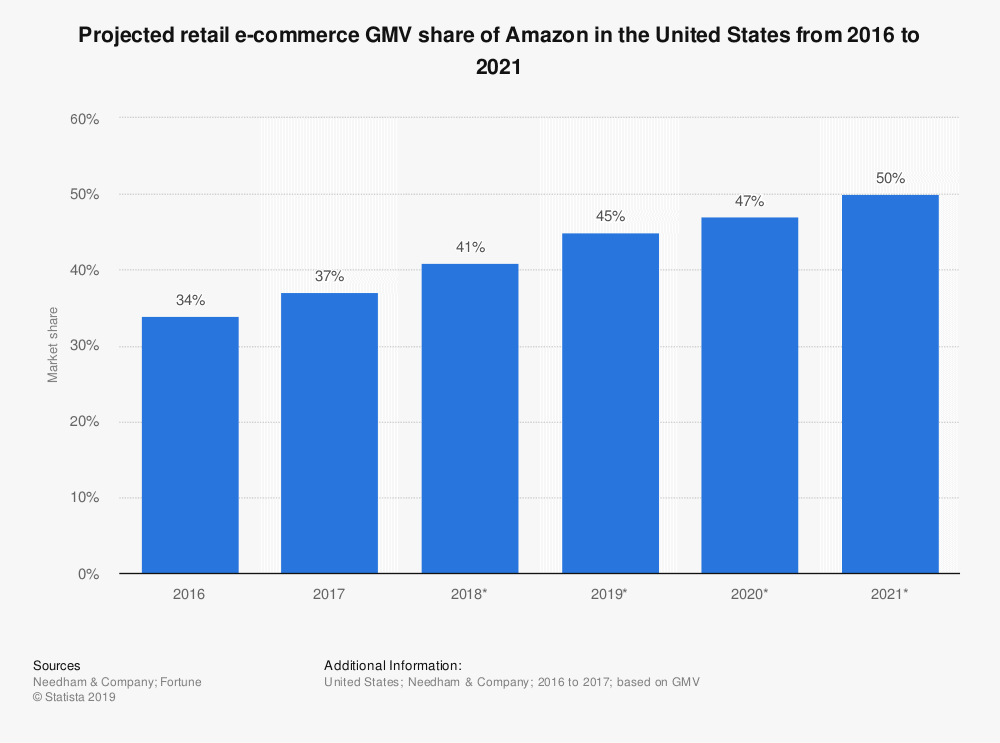
In order to successfully compete, you need to play to your strengths and lean into what makes your brand different. Here are some of the top strategies ecommerce marketers have used to carve out their own niche and get shoppers to choose their online store over Amazon.
3 Reasons Shoppers Choose Amazon (And How Your Brand Can Compete)
There are a few good reasons why Amazon has become so popular over the last decade. With products extending into virtually every category imaginable, competitive pricing, and guaranteed shipping options, most online shoppers have little reason to look anywhere else.
But while it may be impossible to match Amazon from a size and scale perspective, you can look at some of their top-selling points for inspiration to help differentiate your brand.
1. An unmatched selection of products

Bacon bandages. Game of Thrones coloring books. A 188” inflatable elephant. You can find just about anything on Amazon. But while this “one-stop-shop” approach is convenient, it also means shoppers aren’t getting the same level of quality or expertise they might be looking for. It’s like when you go to a diner and they have everything on the menu—you already know that it’ll probably not be the best place to order a lobster dinner.
Opportunity? Focus on brand and product education.
For all that Amazon does provide its sellers, it’s missing these two important things:
- The ability to build and reinforce your brand as the place to shop for one particular type of product.
- The opportunity to educate shoppers on your category and the specific value proposition of your product.
You can do both of those things with your own website and ecommerce landing pages. Building a relationship with your shoppers through your owned sales channels can earn their loyalty, show shoppers why you’re the best retailer for this category of products, and make them more likely to come back for more.
2. Fast, reliable shipping

Amazon Prime has spoiled us—and the rest of the shopping public—when it comes to shipping and delivery. Many a shopping cart have been abandoned upon learning of high shipping costs or long delivery times.
Opportunity? Focus on customer service—or join them.
Luckily, more and more fulfillment providers are offering fast shipping times. Deliverr just raised $40 million earlier this year to provide merchants with 2-day shipping at rates lower than Fulfillment by Amazon (FBA).
If that’s not feasible for your business model, you can also compete on customer service. Shopping on Amazon is impersonal, to say the least. Focus on providing fast, friendly service and every other aspect of customer retention to get a leg up on the ecommerce giant.
3. Competitive pricing

Economies of scale are no joke, and if there’s one thing Amazon has—it’s scale. 49% of internet users in the U.S. say they shop on Amazon because they have the best prices. But in reality, Amazon isn’t always the cheapest option—and you may have an opportunity to sweeten the deal for customers in other ways, too.
Opportunity? Focus on enticing discounts and promotions.
To compete with Amazon’s low prices, you need to offer enticing discounts on your ecommerce website and landing pages. When a customer feels like they’re getting a good deal, it increases the likelihood that they’ll convert. For some tips on how to use discounts and promos to bring in more online sales, check out some of the strategies ecommerce experts are using for Black Friday 2020.
3 Weaknesses of Amazon (Your Brand Can Capitalize On)
Amazon is masterful at getting users to convert. The website, mobile app, and single-click checkout process contribute to the company’s success. But there are some areas where Amazon doesn’t perform as well, and you can focus on these areas to provide a better shopping experience and convert more browsers into buyers.
1. Cluttered, distracting pages
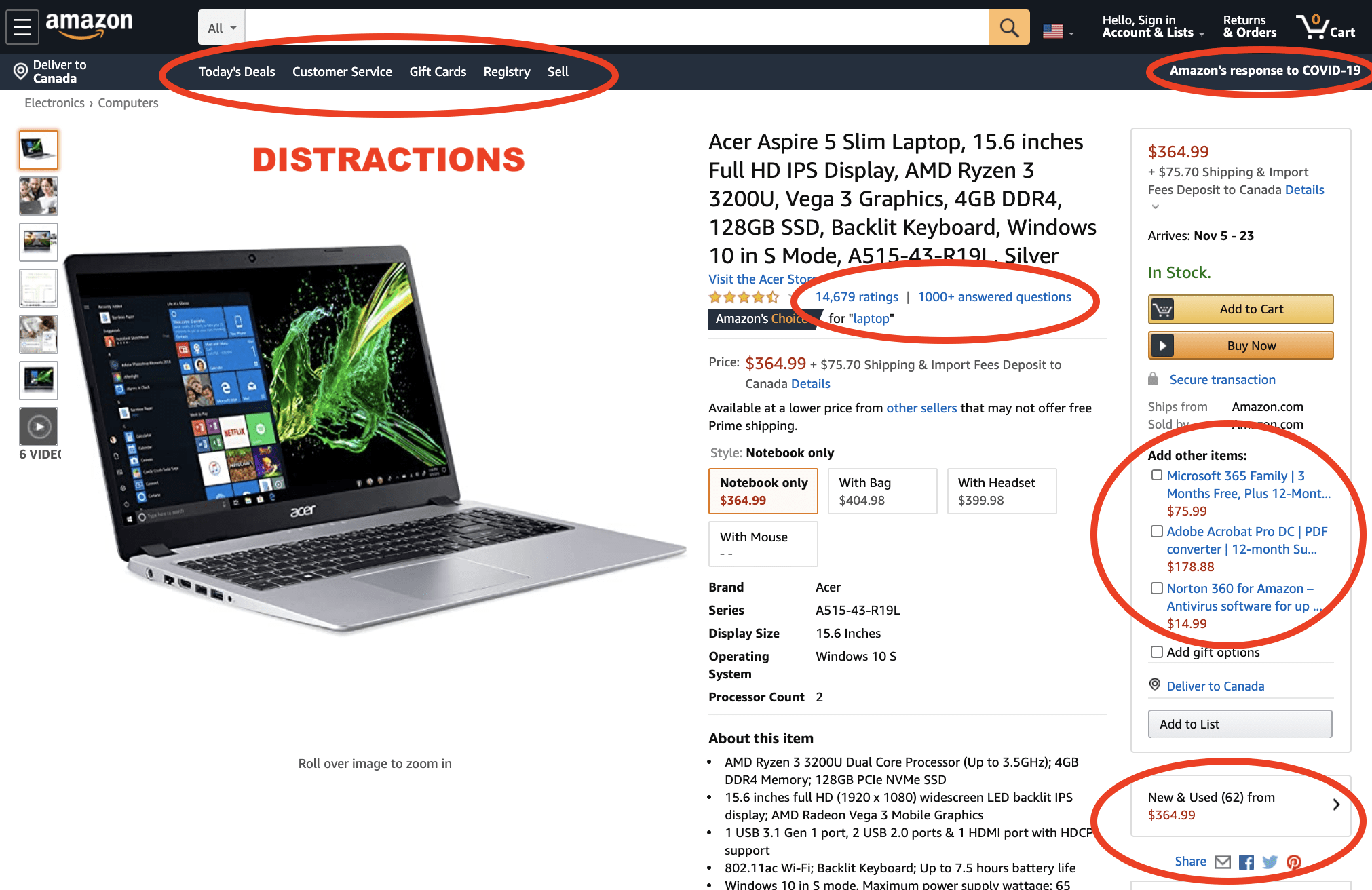
When you think about all the things that Amazon brings to the world, elegant design is not one of them. Remove friction from the buyer’s journey with a cleanly designed landing page engineered to usher shoppers through conversion, and you’ll increase the likelihood of making a sale.
Editor’s Note: Want to make your landing page beautiful and high-converting? Learn the 7 Principles of Conversion-Centered Design to see how creating more focus on your landing page can help you increase sales.
2. Long, hard-to-read copy
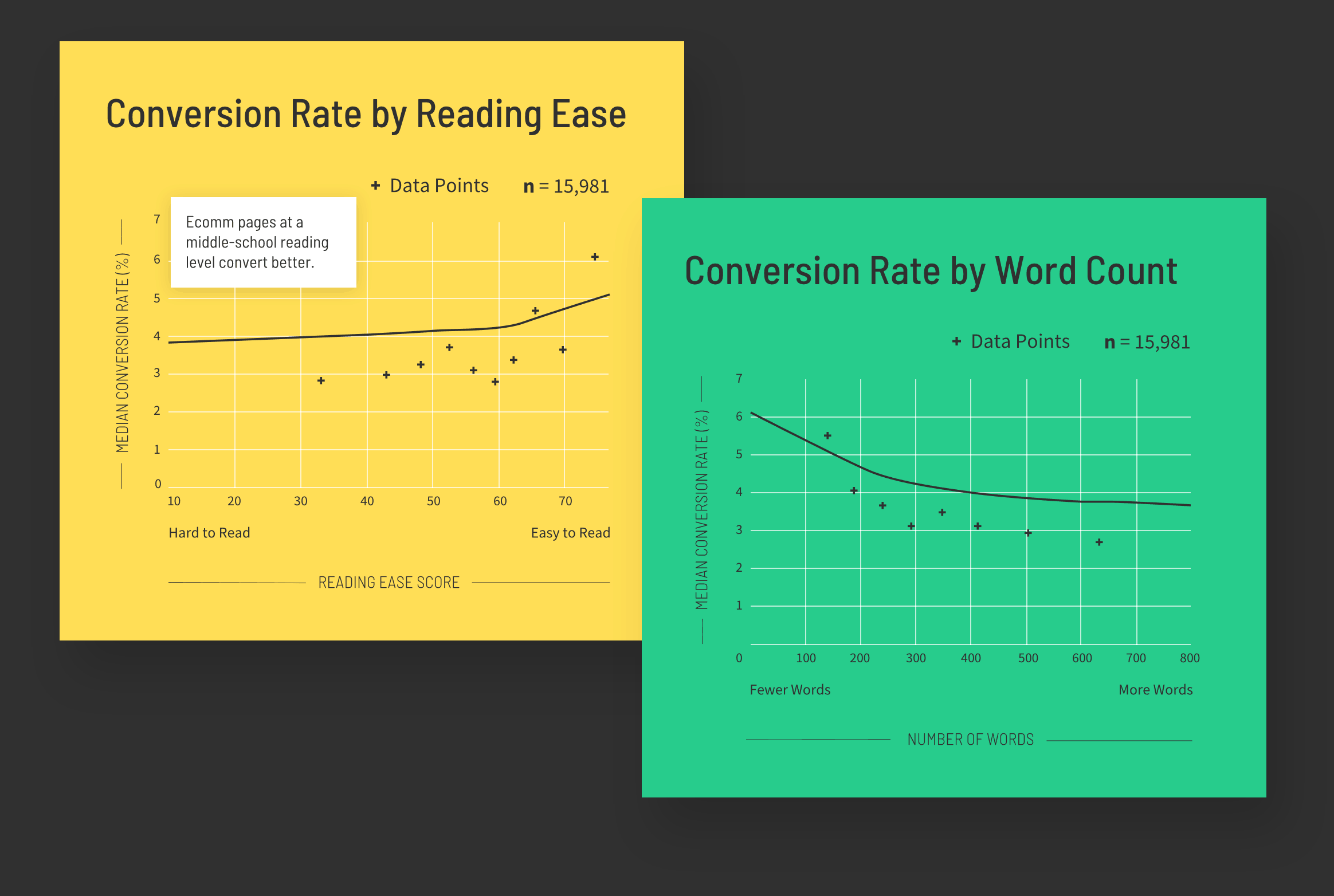
One of the biggest takeaways from the 2020 Conversion Benchmark Report is that the best-converting ecommerce landing pages keep it short and sweet. The study shows that conversion rates typically increase with easier readability scores and decrease with higher word counts. So while pages on Amazon tend to go long (and get technical) sometimes, you can make shopping easier with a simple and user-friendly shopping experience.
3. Generic on-site pages

For the most part, every brand looks the same on Amazon—which means there’s not a lot of opportunity for differentiation. This is where your online storefront and ecommerce landing pages have a chance to shine. Compare the generic Amazon example for an electric toothbrush above to this Unbounce landing page example for a Goby toothbrush. Shoppers are more likely to remember your brand and hit that “Shop Now” button when you put products in the best possible spotlight.
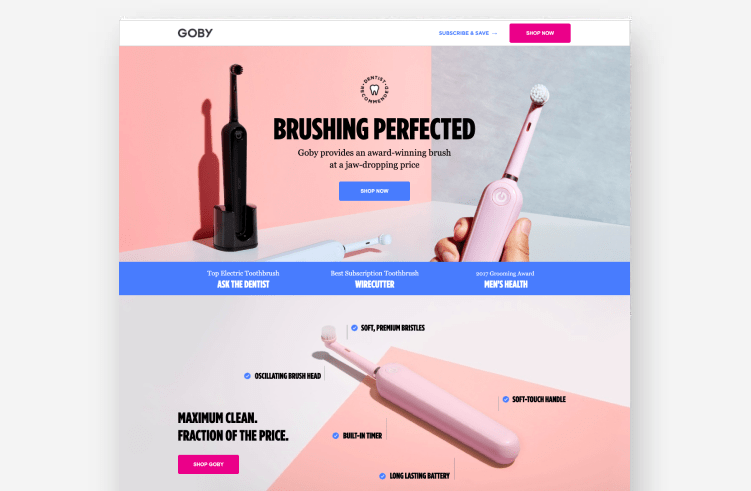
How to Compete with Amazon at Every Stage of the Funnel [A Beginner’s Guide for Online Brands and Marketers]
Competing with Amazon takes brains, not brawn. You need a thorough understanding of the marketing funnel—awareness, consideration, decision, and post-sale—for any hope of growing your sales. Here are some more tips to consider as you move shoppers through the buying journey.
1. Build awareness at the top of funnel
You might make the best-performing running shoe on the planet, but if no one knows your brand exists you’ll never sell a pair. Build awareness by developing a strong brand and getting it in front of potential customers before they realize they need your product.
Run a display ad campaign via Google Ads.
Unlike PPC ad campaigns, which appear based on keywords in search queries, display ads are targeted based on various combinations of demographic and psychographic segments. These can be great for grabbing the attention of potential shoppers. Google Shopping campaigns are also becoming a popular way to get in front of audiences early on in the process.
Leverage social media platforms.
The potential for audience targeting on social platforms is powerful, and the time users spend scrolling every day makes it worth the investment for you to show up there, too—either through paid advertising or organically. Social media is used to some degree in almost every stage of the funnel. Active online engagement, in the places your target audience dwells, can get your brand in front of your future customers.
Earn awareness through word of mouth.
One of the best ways to make people aware of your products is to surprise and delight your current customers so much they tell all their friends and family about you. A little more complicated but doubly effective is through public relations. If your business has an interesting story to tell, you might be able to score some media coverage.
Don’t count out local.
You’ll have an advantage in your own geographic area, especially if you have an active brick-and-mortar there. Leverage local advertising and PR to spread more awareness. If the target market is right for you, some local businesses have found success advertising on Nextdoor.
2. Target shoppers in the consideration stage
Amazon is a popular choice for many reasons, but pricing and shipping are at the top of the list. Your business needs to be able to offer other compelling opportunities that Amazon can’t match.
Educate your shoppers.
Content marketing isn’t just important for search engine optimization—it’s also one area of the funnel where Amazon doesn’t compete. This leaves a door open for you to develop brand trust and create a reputation as an industry leader. Solo Stove, for example, is a leading name in fire pits and camp stoves that has embraced this opportunity with a fun and informative blog, featuring topics their target audience wants to learn more about.

Distinguish your brand.
Think about your ideal customer and their goals and aspirations. Does your on-site branding reflect those aspirations? For instance, you might want to consider positioning your business as a high-end, bespoke shop as opposed to Amazon’s feel of a digital “big box store.” This Unbounce-built landing page example from waterdrop has a conversion rate over 50%—which makes it a prime example of how effective this strategy can be.
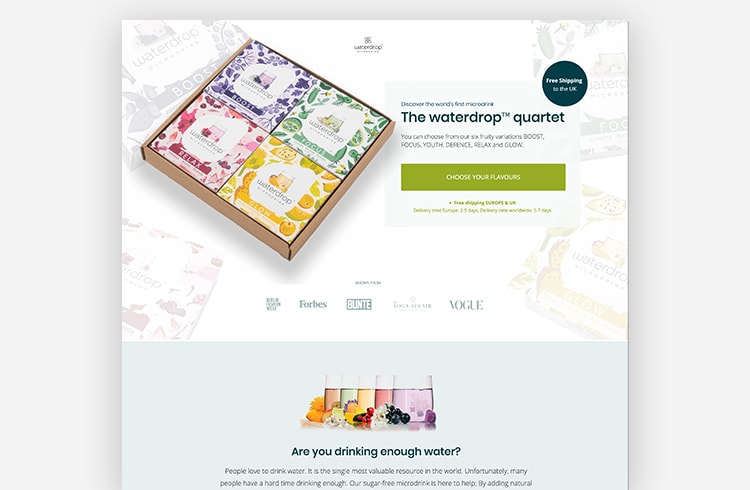
Run a PPC campaign.
Using a targeted Google PPC ad campaign can highlight your brand before customers find Amazon links in the search results, putting you front and center. A well-crafted ad that nails search intent can get your brand at the top of a search results page, letting potential shoppers know that you exist and are ready to meet their needs.

3. Make it easy to purchase at the bottom of funnel
Number of visitors to your site is just a vanity metric unless they’re also converting. The more you can do to turn leads into buyers, the more revenue you can drive to grow your brand.
Leverage a focused, engaging landing page.
If you’re running a specific campaign, using a highly focused, conversion-optimized landing page can help drive conversions. An advantage of a landing page is that it pares down unnecessary elements to keep the user’s attention on the most important elements: the product and the call to action.
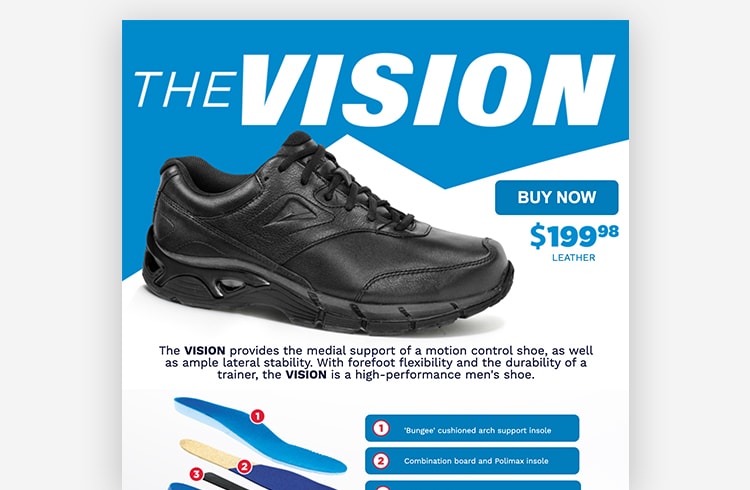
Editor’s Note: Learn how to make your landing page more engaging with data from the Conversion Benchmark Report. We used machine learning to analyze over 15,000 ecommerce landing pages and discovered which emotions and words tend to trigger more sales.
Display customer reviews for social proof.
Customers love reviews—in fact, a whopping 95% of shoppers read reviews before making a purchase. Amazon excels in the review space. All reviews are at the bottom of a product page, and many include images. To be a competitor, you need to feature reviews loudly and proudly.
Here’s how ColdCalm displays their reviews on their product page. It’s cleaner and more obvious than any Amazon page example.

Offer discounts and promotions.
Amazon does many things well, but discounts and promotions generally aren’t a part of the sales strategy. As such, running discounts and promotions is a great way to get a leg up on Amazon. Use your email list to regularly promote new or top-selling products and send promo codes when possible.
In creating discounts, consider using Amazon’s pricing as a base. See how much similar products are selling for on Amazon and try to aim slightly lower. When combined with a free shipping promo, you can ensure your customers get the experience they enjoy with Amazon while staying loyal to your products.
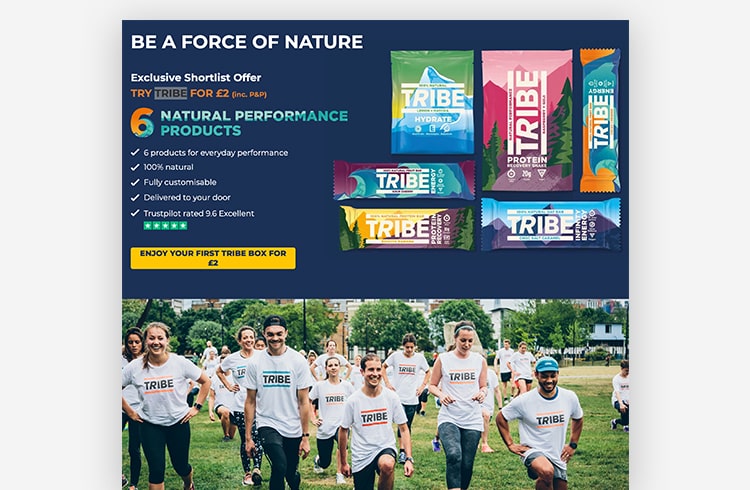
4. Get customers to buy again
Once you have customers on the hook, it’s essential to keep them coming back. A one-time purchase is good, but without a way to generate repeat sales, you could be losing out on a lot of revenue if they choose Amazon next time.
Run a referral program.
A referral program can be an excellent way to keep customers engaged and enthusiastic. This concept is essentially a win-win—it motivates customers to drive business to your brand while also rewarding them for being fans. These programs can be relatively easy to establish and often don’t require a significant upfront investment.
Over 90% of shoppers trust reviews from family and friends, which is why so many of the top subscription box services use referral programs to grow their business. Customers love incentives, so offering a discount in exchange can be a great motivator.
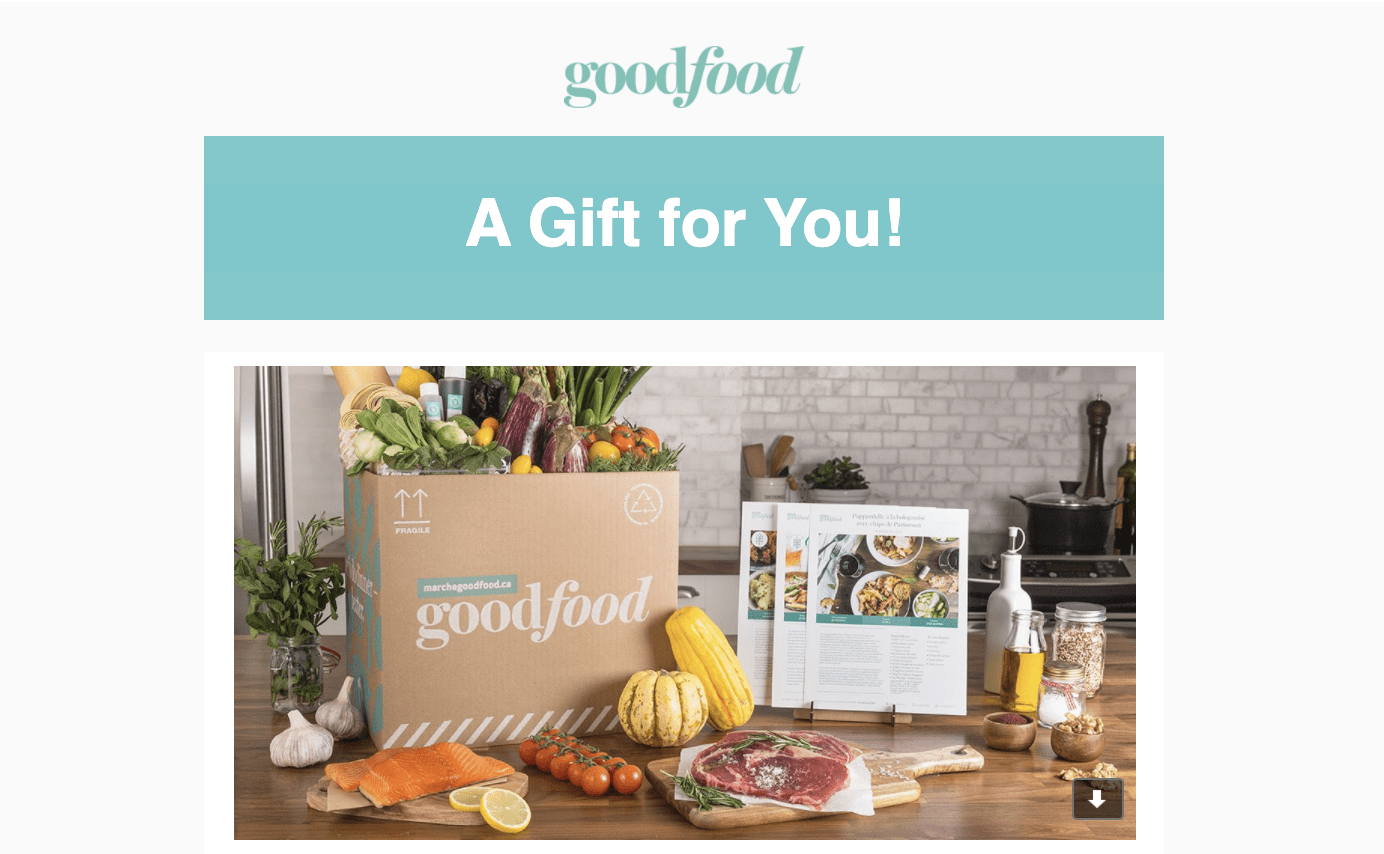
Keep engaging with return customers through email marketing.
Stay in contact with your shopper base via email marketing to remind them of your presence and keep them feeling connected to you. Amazon is an expert at this, with email communications coming regularly enough to keep up customer engagement, but not too often to be annoying.
You can put your own spin on email to announce new product launches, offer promotions, and surface up other content your audience might find useful. Unlike acquisition channels like PPC or social media, nobody owns your email list except for you—which means you have a direct line of communication to shoppers already interested in your product.
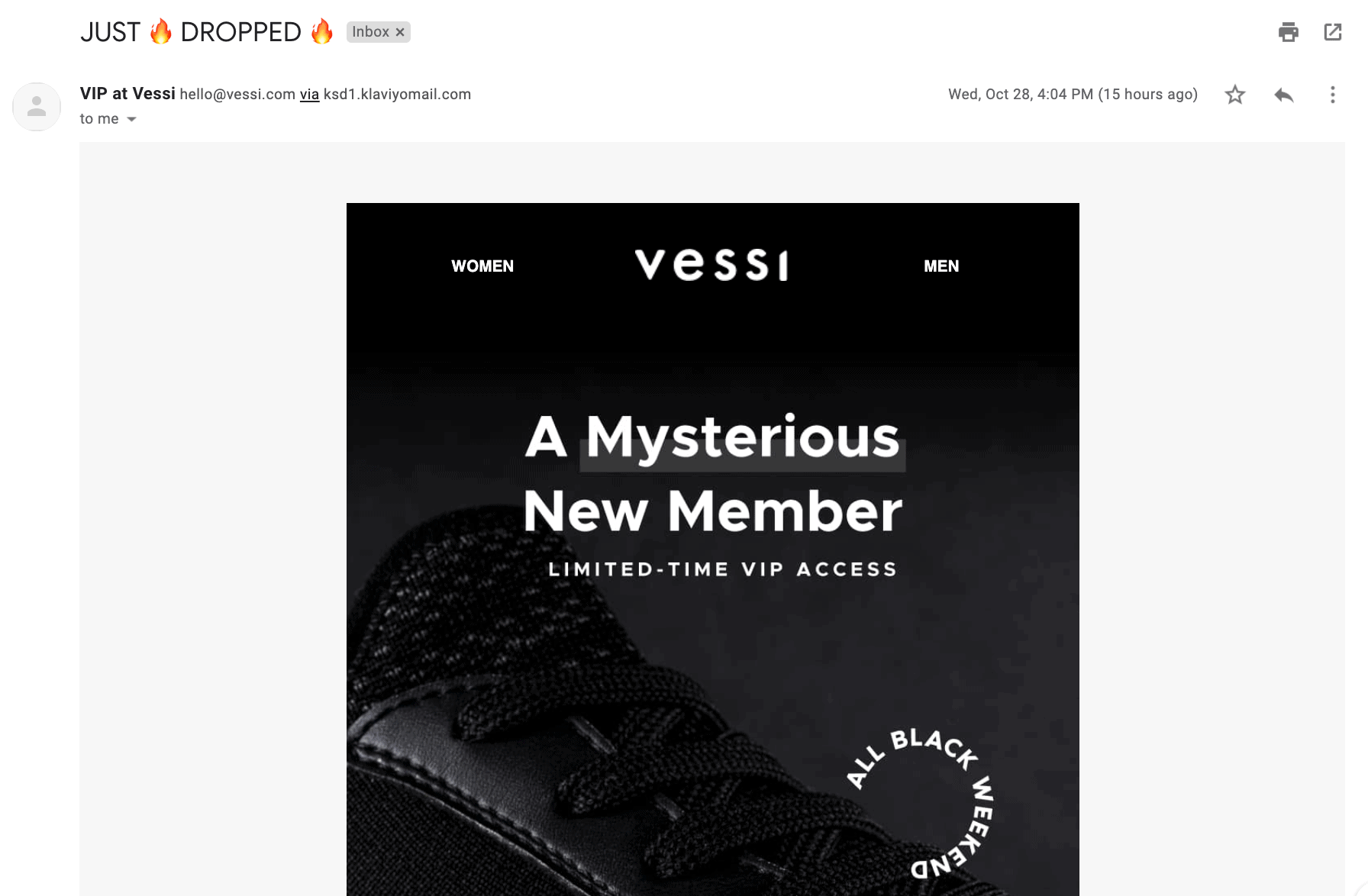
Establish responsive customer service.
Just because customers can’t meet you face-to-face doesn’t mean they won’t have questions that need to be answered. Amazon isn’t always known for customer support, so this is a space where you can outshine the competition.
Here are some of the top ways to provide excellent customer service:
- Offer simple and direct ways for customers to ask questions, including email and chat
- Always aim for fast response rates and turnaround times on customer requests
- Train customer service agents to politely handle queries of all kinds
You Have All the Tools You Need to Compete with Amazon
In a market where Amazon is consistently the front-runner, staying competitive isn’t easy. Still, it’s important to remember that it’s more about playing the game than fighting to be the ultimate victor.
Because with the right marketing plan and ecommerce platform, any brand can attract a strong customer base—despite Amazon, not instead of Amazon. Get started today by building your first ecommerce landing page, or check out the 2020 Conversion Benchmark Report to get more inside scoops and industry insights.

![[Unbounce – TOFU] Conversion Benchmark Report – V1](https://unbounce.com/photos/BLOG-CTA-OPTION-1-scaled.jpg)
